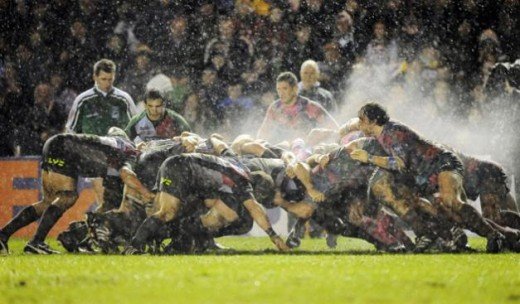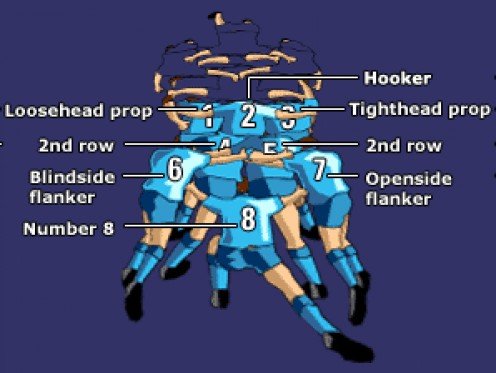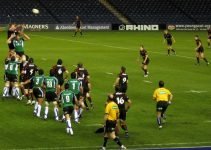THE SCRUM IN RUGBY UNION
The marvel of the rugby union scrum is truly one of rugby’s unique spectacles. Sixteen of the biggest players on the field smash together and push in a desperate bid for the ball. In professional level rugby fixtures this can mean that often two tones of rugby player are colliding together to contest the rugby scrum.

In rugby the ball can only go forward if it is kicked or carried. If a ball goes forward off a player, either by a forward pass, dropped or knocked-on, play resets with a scrum. A rugby scrum also occurs when the ball is trapped in a ruck or maul or if a player is accidentally offside. A team can also choose to take a scrum when they are awarded a penalty.
The scrum in rugby looks like a big huddle where the eight forwards from each side link up in three rows and push against the eight forwards from the other team. The half back rolls the ball in at the front where the two teams meet and his team tries to kick the ball back to the rear of the scrum where they can then pick it up and use it.
RUGBY SCRUM POSITIONS
Here are the rugby player positions who participate in the scrum, and what each one does.

THE RUGBY SCRUM FRONT ROW
The ‘front row’ of each team smashes against each other at the front of the rugby scrum, with the rest of their forwards pushing behind them. The front row is made up a prop on each side with a ‘hooker’ in the middle. The hooker is the player who ‘hooks’ the ball back to his team when the half back rolls it in. He also throws the ball in at the lineout.
When the front row of each team engages, the heads of the prop entwine with the opposing prop. The loosehead prop, wearing jersey number one, has one of his ears on the outside on the scrum. On the other side, the tighthead prop has both of his ears bound in the scrum. That player wears number three. The tighthead’s role is to provide stability to the scrum, while the loosehead is generally the attacker of the other team’s scrum.
THE RUGBY SCRUM SECOND ROW
Behind the front row is the second row. This is where the two locks take their place in the rugby scrum. The five players are known as the ‘tight five’ and most of the scrum’s power is generated by these players.
THE FLANKERS AND NO. 8: THE BACK ROW
Completing the rugby union scrum are the three loose forwards. There is a flanker on each side of the two locks and the number eight is at the back of the scrum ready to receive the ball as it gets kicked to the back by his team. The blindside flanker usually packs down on the side of the scrum with less distance to the sideline. The openside flanker packs down on the side with more space, as they are usually faster and can cover more ground.
RUGBY SCRUM HALF
The scrum half, more commonly referred to as the halfback, wears the number nine jersey and is the only non-forward who participates in the scrum. However, the scrum half does not pack down, instead they are responsible for putting the ball into it, and often taking it out at the other end. Usually the opposing halfback stands remains next to his opposite number. However, the opposition nine is not able to move past the other team’s number eight until the ball is out the back of the rugby scrum.
HOW THE RUGBY SCRUM WORKS
The scrum in rugby union is completely contested. Referees watch carefully to make sure both team engage at the same time and bind correctly, and try to make sure the halfback puts the ball into the rugby union scrum fairly straight. From there a torrid affair begins where both teams push and twist trying to force their way over the ball or to disrupt the other team.
A lot of pressure goes through the spines of the tight five, and especially the front row. Because of this, specialists are required for the front row positions, and if a team cannot provide enough front row specialists at any point of the game then rugby scrums become ‘uncontested’, for safety’s sake.
Due to all the different technical elements involved in a rugby union scrum there are usually a lot of scrum resets as the referee tries to bring all the different elements together at the right time, including how square the front rows are to each other, the teams are pushing straight, are the correct distance apart, the binding of all 16 forwards is correct, and that the halfback is putting the ball in straight. Furthermore, because of the force expended and the fact that rugby is a winter sport members of the front row might slip over, causing another reset.
AFTER THE RUGBY SCRUM
Anything can happen after the rugby scrum. The opposing team can disrupt it enough to steal possession, cause a scrum reset, or even be rewarded a penalty. However, should the scrum go according to plan for the team in possession, the ball will find itself safely under the feet of the number eight. If the rugby scrum is moving forward then the number eight may choose to keep the ball in the scrum there while his team moves valuable inches up the field. In rare cases the scrum may even manage to push over the try line and somebody places a hand on the ball to score a try. This is called a pushover try.
However, in most cases the ball will need to be taken from the scrum and used by the team in possession. This usually happens one of two ways. The half back takes it from under the legs of the number eight or the number eight picks it up. The team may try and run the ball or up or kick it up field.
THE HISTORY OF THE RUGBY SCRUM
The rugby union scrum has continued to evolve along with the other elements of rugby union. It began as barely a more structured ruck without set positions. Around the turn of the 20th century it evolved into a 2-3-2 formation, played with seven players. By 1950 3-2-3 and 3-3-2 formations had also been trialled, before South Africa led the move into the current 3-4-1 set up. Since then positions within the scrum have become more specialised, such as the distinction between the tight head and loose head props and allowing the number 8 to detach from the scrum holding the ball.
RUGBY SCRUM COMMANDS
In recent years one of the biggest changes to the rugby union scrum rules has been to the commands. In 2007 law-makers introduced “crouch, touch pause, engage” commands from the referee. For safety reasons the new commands, as well as increased control of the distance between the two front rows as well as trying to ensure they engage at the same time.
A new call, “crouch, bind, set”, has been trialled since 2013, which further reduces the distance between the front rows. Referees are asked to ensure neither team pushes before the ball is fed in.
HOW TO SCRUM IN RUGBY: RUGBY SCRUM DRILL, TECHNIQUES, COACHING AND TRAINING
“A good powerful scrum is eight people working in the same direction at the same time and understanding the best pushing position. We try and get all eight guys to do the same thing at the same time.” – Mike Cron, All Blacks Forwards Coach
Mike Cron is one of the preeminent experts in the rugby scrum. Before becoming a specialist scrum coach for the All Blacks in 2004 he had already made a name for himself as a true student of the ‘dark arts’, using a scientific approach to figuring out what makes the scrum tick. He was the Canterbury Scrum Coach from 1988 to 2002, and performing the same role for the Crusaders from 1997 also. He worked with the Wales team from 2002-2003. In 2012 he broadened his role with the All Blacks, taking responsibility for the forwards under Steve Hansen.
Cron’s philosophy to scrum coaching focuses heavily on individual technique and the eight forwards operating as an effective unit.
He uses the rugby scrum machine, otherwise known as the scrum sled. However, he is a staunch proponent of opposed scrummaging sessions. Cron uses the single man sled daily, working with a prop and a lock hitting the machine, insuring they are operating as a unit.
In terms of technique, he believes that he core is the key to scrummaging. Some of Mike Cron’s tips include tilting the pelvis backwards before crouching. This helps ensure the back stays straight. He also states that having a player’s head tilted too high or low can cause neck injuries during engagement. When engaging, pretend you are wearing sunglasses and only tilt your head down enough to just see over the top of them. Finally, in the front row your weight needs to be on the balls of your feet, but this doesn’t mean heels should be high off the ground, because this promotes instability.
SCRUM TECHNIQUES FOR SAFETY
The scrum can be one of the most dangerous elements in the game, and good technique is paramount. In particular, there is the potential for neck injuries in the front row if there is poor technique and execution during engagement and pushing. Also, there is a risk of injury if one pack is too dominant over the other or when the scrum collapses.
Some important safety tips include making sure that the two front rows are safe distance apart when crouched and bound together. This is done by the four props reaching over and touching their opponent’s shoulder during the ‘touch’ phase of the refs engagement call.
It is important that the players’ feet, hips and shoulders are all square and that shoulders are always above the hips. When crouching, make sure the knees are bent, not just the hips. When about to engage, make sure the eyes are focused on the target area.
RUGBY SCRUM CAPS AND CAULIFLOWER EARS
You may have noticed some forwards with distinctively distorted ears, where the outer ear has become permanently swollen and deformed. These are called cauliflower ears and often occur from repeated friction or impact and trauma to the ear. As such, it is prevalent in sports such as boxing, wrestling and players who participate in the rugby scrum. You can often tell a rugby player’s specific position by what cauliflower ears they have. For example, the hooker and tighthead prop have two cauliflower ears and the loosehead prop only has one. The locks will have two cauliflower ears and the flankers will have one each. Scrum caps, or ‘scrum hats’ as they are sometimes called are occasionally worn to prevent cauliflower ears. Another technique players use is taping their ears down. However, most forwards seem to either wear their cauliflower ears as a badge of honour, or the preventative measures are too cumbersome during game time.Some players may believe scrum caps offer protection from concussion, but this is disputed.
THE DEBATE OVER THE SCRUM IN RUGBY
The rugby scrum is a contentious issue in the modern game. Rugby purists decry the depowering of the scrum and point to it as a point of difference between other sports, not to mention its importance in keeping rugby a game for all sizes. If you take away the importance of the scrum, the need for large bulky props will be removed. Also, reducing the importance of the scrum will result in the game of rugby turning into rugby league.
However, in the modern-day, television-audience focused game, there is much debate around whether the rugby union scrum takes away from the game as a spectacle. In fact, there has been the recent addition of a ‘scrum clock’ to many televised games. The scrum clock measures the time spent on scrums, particularly through scrum resets.
Even though the scrum has been completely depowered in rugby league, it remains as a tool to tie up some of the games bigger players to create space and attacking opportunities for the faster backs.
RUGBY LEAGUE SCRUM
Fans new to the games of union and league may be slightly confused when they see how differently scrums operate between the two sports. In league the scrum is used purely as a means of starting play that ties up the forwards, leaving more space for the backs to manipulate.
While this is also true of a rugby scrum too, but in rugby union the scrum is treated as a contest in itself. Although the ball can be turned over in a league scrum, this is rare and teams are almost guaranteed to get their own ball back.
Share:


